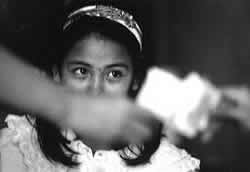Cambodia Struggle with AIDSJanuary 1995


The first case of AIDS infection was reported in Cambodia in May 1991. Last year 39.6% of prostitutes in Sihanoukville were found infected with the AIDS virus and 6.76% of the citizens who donated blood at the National Blood Transfusion Center in January of this year were found infected. Considering that the rates were 9.2% (the mean value of the infection rates of some areas) and 0.59% respectively in 1992, it is feared that the number of AIDS-infected people will increase markedly.
The AIDS Control Office of the Health Ministry says that the number of AIDS-infected people has increased sharply because 1) prostitution and venereal disease go on increasing after the mandate of the United Nations, 2) refugees are coming back from Vietnam and Thailand, 3) injections are often given for treatment according to the medical custom, 4) the safety of blood transfusion is not assured, and 5) the social status of women is low. An analysis of the questionnaire survey conducted before the tests showed that the most of the AIDS patients had been infected through heterosexual intercourse.
A prostitute said, “Three or four out of ten clients don’t wear condoms. But I can’t refuse them because they are drunk or have guns.”
While the Health Ministry can’t take sufficient preventive measures against AIDS infection because of financial difficulties, local nongovernmental organizations (NGOs) are making strenuous efforts. An NGO, the Cambodia Development Association for Women, has visited to various brothels in Phnom Penh since 1992 to give the workers accurate information on AIDS and to teach them how to protect themselves from AIDS. In consideration of the literacy rate of about 40%, the association gives the AIDS education mainly by word of mouth and uses a lot of illustrations. It also gets the workers to practice putting on a condom using a model.
Besides that, the association gives free English lessons to unemployed women who completed the high school course so that they can work in the tourist industry. Another NGO, Kemara, opened a work-training school in 1993 and has taught traditional textile weaving and dressmaking on a machine, but it limits its students to women living in two villages on the outskirt of Phnom Penh because of lack of funds. To ‘show a solution to the women’s issues.’ seems to be all it can do.
Owing to reckless deforestation, a flood devastated the crops last year. Without an increase in income, a merchandise economy is infiltrating into the society. While the number of farmers who work away from home is increasing, the manufacturing industry that creates jobs is growing slowly because the infrastructure and legal system have not completely established and public order is not secured. In this social background housewives are urged to prostitution, girls are sold to brothels, and men who are afraid of being infected with AIDS favor young prostitutes. The weak such as farmers, women and children are suffering from AIDS, which is referred to as a social disease.
The Health Ministry estimated the number of AIDS-infected people in the country to be ‘more than 6,000.’ If this is calculated in terms of the population ratio of Cambodia to Japan, the number of AIDS-infected Japanese comes to more than 70,000.
